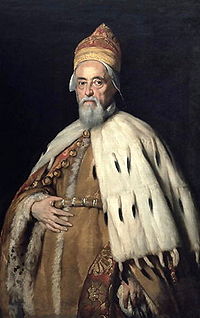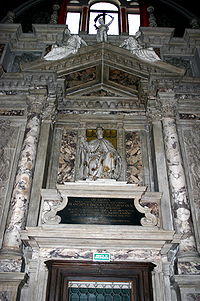
Francesco Erizzo
Encyclopedia

Doge of Venice
The Doge of Venice , often mistranslated Duke was the chief magistrate and leader of the Most Serene Republic of Venice for over a thousand years. Doges of Venice were elected for life by the city-state's aristocracy. Commonly the person selected as Doge was the shrewdest elder in the city...
, reigning from his election on April 10, 1631 until his death fifteen years later. His reign is particularly notable because the last year of his reign saw the beginning of a war
Cretan War (1645–1669)
The Cretan War or War of Candia , as the Fifth Ottoman–Venetian War is better known, was a conflict between the Republic of Venice and her allies against the Ottoman Empire and the Barbary States, fought over the island of Crete, Venice's largest and richest overseas possession...
with the Ottoman Empire
Ottoman Empire
The Ottoman EmpireIt was usually referred to as the "Ottoman Empire", the "Turkish Empire", the "Ottoman Caliphate" or more commonly "Turkey" by its contemporaries...
for control of Crete
Crete
Crete is the largest and most populous of the Greek islands, the fifth largest island in the Mediterranean Sea, and one of the thirteen administrative regions of Greece. It forms a significant part of the economy and cultural heritage of Greece while retaining its own local cultural traits...
that would last for 24 years and dominate the geopolitics
Geopolitics
Geopolitics, from Greek Γη and Πολιτική in broad terms, is a theory that describes the relation between politics and territory whether on local or international scale....
of the Mediterranean.
Background, 1566-1631
Francesco Erizzo was born into the House of Erizzo, a patrician family from IstriaIstria
Istria , formerly Histria , is the largest peninsula in the Adriatic Sea. The peninsula is located at the head of the Adriatic between the Gulf of Trieste and the Bay of Kvarner...
. Although he was not particularly rich (in no small part because he had to cover for the debts of his brother), he nevertheless had a successful career in the service of Venice. He acted as Venetian ambassador
Ambassador
An ambassador is the highest ranking diplomat who represents a nation and is usually accredited to a foreign sovereign or government, or to an international organization....
to both Ferdinand II, Holy Roman Emperor
Ferdinand II, Holy Roman Emperor
Ferdinand II , a member of the House of Habsburg, was Holy Roman Emperor , King of Bohemia , and King of Hungary . His rule coincided with the Thirty Years' War.- Life :...
and Pope Urban VIII
Pope Urban VIII
Pope Urban VIII , born Maffeo Barberini, was pope from 1623 to 1644. He was the last pope to expand the papal territory by force of arms, and was a prominent patron of the arts and reformer of Church missions...
. He also served as provveditore
Provveditore
The Italian title provveditore or proveditore , "he who sees to things", was the style of various local district governors in the extensive, mainly maritime empire of the Venetian dogal republic...
of various Venetian possessions. Erizzo never married.
Doge, 1631-1646
Erizzo was elected as Doge of Venice on April 10, 1631, in the midst of the Italian plague of 1629–1631, which killed one third of the population of Venice, including Erizzo's predecessor Nicolò ContariniNicolò Contarini
Nicolò Contarini , was the 97th Doge of Venice, reigning from his election on January 18, 1630 until his death 15 months later...
. He was elected by a vote of 40-1, although historian
Historian
A historian is a person who studies and writes about the past and is regarded as an authority on it. Historians are concerned with the continuous, methodical narrative and research of past events as relating to the human race; as well as the study of all history in time. If the individual is...
Claudio Rendina has pronounced this election fraudulent. (The only dissenting vote was cast for Renier Zen, the opponent of Giovanni I Cornaro
Giovanni I Cornaro
Giovanni I Corner or Cornaro was the 96th Doge of Venice, reigning from January 24, 1625 until his death.-Early years, 1551-1625:He was the son of Marcantonio Cornaro and Cecilia Giustinian...
known for his incorruptibility.)
In light of the bubonic plague
Bubonic plague
Plague is a deadly infectious disease that is caused by the enterobacteria Yersinia pestis, named after the French-Swiss bacteriologist Alexandre Yersin. Primarily carried by rodents and spread to humans via fleas, the disease is notorious throughout history, due to the unrivaled scale of death...
then decimating the city (it would claim 45,000 victims in all), Erizzo's election was not accompanied by the customary festivities. The plague finally subsided in November 1631. Erizzo's predecessor, Nicolò Contarini
Nicolò Contarini
Nicolò Contarini , was the 97th Doge of Venice, reigning from his election on January 18, 1630 until his death 15 months later...
, had taken a vow
Vow
A vow is a promise or oath.-Marriage vows:Marriage vows are binding promises each partner in a couple makes to the other during a wedding ceremony. Marriage customs have developed over history and keep changing as human society develops...
to build a church in honour of the Blessed Virgin Mary once the plague was over, which church was built and named Santa Maria della Salute. Erizzo now ordered that Venice would celebrate the Feast of the Presentation of Mary
Presentation of Mary
The Presentation of the Blessed Virgin Mary , or The Entry of the Most Holy Theotokos into the Temple , is a liturgical feast celebrated by the Roman Catholic, Eastern Catholic, and Orthodox Churches....
(November 21) as the Festa della Madonna della Salute, where the city's officials parade from San Marco
San Marco
San Marco is one of the six sestieri of Venice, lying in the heart of the city. San Marco also includes the island of San Giorgio Maggiore...
to the Salute in the sestiere Dorsoduro
Dorsoduro
Dorsoduro is one of the six sestieri of Venice, northern Italy.Dorsoduro includes the highest land areas of the city and also Giudecca island and Isola Sacca Fisola...
for a service in gratitude for deliverance from the plague. This tradition is still observed in Venice to this day.

Republic of Venice
The Republic of Venice or Venetian Republic was a state originating from the city of Venice in Northeastern Italy. It existed for over a millennium, from the late 7th century until 1797. It was formally known as the Most Serene Republic of Venice and is often referred to as La Serenissima, in...
. The Procuratie
Procuratie
The Procuratie are three connected buildings on St Mark's Square in Venice. They are also connected to St Mark's Clocktower...
were expanded (with gambling
Gambling
Gambling is the wagering of money or something of material value on an event with an uncertain outcome with the primary intent of winning additional money and/or material goods...
becoming a popular pastime there), and the Teatro San Cassiano
Teatro San Cassiano
The Teatro San Cassiano or Teatro di San Cassiano in Venice was the first public opera house when it opened in 1637. The theatre takes its name from the neighbourhood where it was located, the parish of San Cassiano near the Rialto. It was a stone building owned by the Venetian Tron family...
, Europe's first public opera house
Opera house
An opera house is a theatre building used for opera performances that consists of a stage, an orchestra pit, audience seating, and backstage facilities for costumes and set building...
opened in 1637, with the Teatro San Moisè
Teatro San Moisè
The Teatro San Moisè was an opera house in Venice, active from 1640 to 1818. It was in a prominent location near the Palazzo Giustinian and the church of San Moisè at the entrance to the Grand Canal....
following in 1640.
The tranquility of the era was interrupted briefly by the First War of Castro, in which the Papal States
Papal States
The Papal State, State of the Church, or Pontifical States were among the major historical states of Italy from roughly the 6th century until the Italian peninsula was unified in 1861 by the Kingdom of Piedmont-Sardinia .The Papal States comprised territories under...
claimed the Duchy of Castro
Castro (city)
Castro was an ancient city on the west side of Lake Bolsena in the present-day comune of Ischia di Castro, northern Lazio, Italy. It was destroyed at the conclusion of the Wars of Castro in the 17th century.-Early history:...
, which was under the control of the Duchy of Parma
Duchy of Parma
The Duchy of Parma was created in 1545 from that part of the Duchy of Milan south of the Po River, as a fief for Pope Paul III's illegitimate son, Pier Luigi Farnese, centered on the city of Parma....
. Venice intervened on Parma's side, and in 1644 a peace treaty was signed that saw Castro remain with Parma.
In September 1644, the Knights of Malta
Knights Hospitaller
The Sovereign Military Hospitaller Order of Saint John of Jerusalem of Rhodes and of Malta , also known as the Sovereign Military Order of Malta , Order of Malta or Knights of Malta, is a Roman Catholic lay religious order, traditionally of military, chivalrous, noble nature. It is the world's...
captured a galleon
Galleon
A galleon was a large, multi-decked sailing ship used primarily by European states from the 16th to 18th centuries. Whether used for war or commerce, they were generally armed with the demi-culverin type of cannon.-Etymology:...
of Turkish
Ottoman Empire
The Ottoman EmpireIt was usually referred to as the "Ottoman Empire", the "Turkish Empire", the "Ottoman Caliphate" or more commonly "Turkey" by its contemporaries...
pilgrims
Pilgrimage
A pilgrimage is a journey or search of great moral or spiritual significance. Typically, it is a journey to a shrine or other location of importance to a person's beliefs and faith...
bound for Mecca
Mecca
Mecca is a city in the Hijaz and the capital of Makkah province in Saudi Arabia. The city is located inland from Jeddah in a narrow valley at a height of above sea level...
and then sought refuge in Candia (modern Heraklion
Heraklion
Heraklion, or Heraclion is the largest city and the administrative capital of the island of Crete, Greece. It is the 4th largest city in Greece....
) on Venetian-controlled Crete
Crete
Crete is the largest and most populous of the Greek islands, the fifth largest island in the Mediterranean Sea, and one of the thirteen administrative regions of Greece. It forms a significant part of the economy and cultural heritage of Greece while retaining its own local cultural traits...
. Ottoman Sultan Ibrahim I
Ibrahim I
Ibrahim I was the Sultan of the Ottoman Empire from 1640 until 1648. He was born in Istanbul the son of Ahmed I by Valide Sultan Kadinefendi Kösem Sultan, an ethnic Greek originally named Anastasia...
blamed Venice for the attack and determined to conquer Crete from Venice. The war originally went poorly for Venice, which led Erizzo to ask the Senate of Venice to appoint him captain-general, which they did, over the objection of future doge Giovanni Pesaro
Giovanni Pesaro
Giovanni Pesaro was the 103rd Doge of Venice, reigning from his election on April 8, 1658 until his death. The Cretan War was ongoing for the entirety of his brief reign....
. Erizzo began assembling a fleet
Naval fleet
A fleet, or naval fleet, is a large formation of warships, and the largest formation in any navy. A fleet at sea is the direct equivalent of an army on land....
to sail against the Turks, but, at age 78, his health failed him, and he died only one month after his military appointment, on January 3, 1646.

